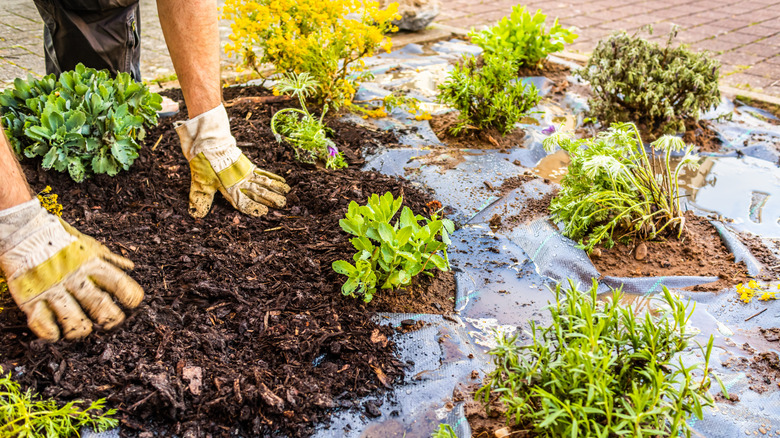Biodegradable Mulch Vs Landscaping Fabric For Weeds: Which Is Best?
When it comes to getting rid of weeds in your garden or landscape without the use of chemicals, there are two great options to choose from: biodegradable mulch and traditional landscaping fabric. Both are effective tools for suppressing weeds, conserving moisture, and aiding healthy plant growth. However, they differ significantly in materiality, functionality, and environmental impact. While it's tempting to crown one as the "better" option, each serves slightly different needs. Let's look at what sets them apart and how they might fit into your weeding plans.
When most people think of mulch, they probably picture bark chips or straw. However, biodegradable mulch is something entirely different. Made from plant byproducts like cornstarch, it resembles a plastic sheet and smothers weeds the same way traditional landscaping fabric does. The main difference is that biodegradable mulch breaks down over time, enriching the soil as it decomposes. While some biodegradable mulches are certified for organic farming in certain countries, they don't meet the USDA National Organic Program's (NOP) criteria, making them unsuitable for organic operations in the United States.
Landscaping fabric, on the other hand, is a material made from synthetic fibers like polyester or polypropylene (although some woven varieties are made from linen). It's durable, reusable, and often paired with a layer of mulch or decorative stones for aesthetic appeal. Both materials block sunlight, preventing weed growth while allowing water and nutrients to reach the soil. The choice between the two ultimately depends on your goals, garden setup, and environmental priorities.
Pros and cons of biodegradable mulch
Biodegradable mulch provides a combination of both effectiveness and sustainability. It suppresses weeds comparably to landscaping fabric, but it has the added advantage of breaking down naturally, leaving no trace behind, which eliminates microplastics in the soil. This can be particularly beneficial in vegetable gardens, where soil health is directly tied to plant productivity.
Another advantage is that it saves time and labor. Unlike traditional plastic mulch, which requires you to physically remove it once it's worn out, biodegradable mulch decomposes directly in the soil, eliminating the need for removal. This significantly reduces the amount of manual labor while also ensuring that you don't harm your plants in the process. Additionally, biodegradable mulch retains soil moisture effectively, reducing watering needs during dry spells.
However, biodegradable mulch is not without its drawbacks. Its lifespan is limited, particularly in hot or wet climates and during warm seasons, since heat and moisture cause it to degrade faster than normal. This makes it less ideal for long-term projects, like perennial flower beds or shrubbery. Additionally, the upfront cost of biodegradable mulch is also higher than that of traditional plastic or landscaping fabric, which may be a concern if you're working within a budget.
Pros and cons of landscaping fabric
Traditional landscaping fabric has been a go-to solution for weed control for decades. Its durability makes it suitable for long-term use in flower beds, walkways, and other areas where weeds are a persistent problem. Once installed and covered with mulch or stones, it can effectively block sunlight, reducing the need for frequent weeding or maintenance.
Landscaping fabric is also highly versatile, as you can cut it to fit gardens of various shapes and sizes. It's especially effective for paths or hardscaping projects where you need a long-term solution. However, its long-lasting nature can be both a benefit and a drawback. If you're wondering if landscape fabric is really safe to use in your vegetable garden, the answer is nuanced. Since it stays in place for a long time, it can negatively impact soil health over time by compacting the soil and limiting air and water flow to plant roots.
Although the black landscaping fabric can kill weeds, it can also kill seedlings due to the trapped heat, especially if it's in a sunny spot. Also, while landscaping fabric can suppress weeds effectively for a time, weed seeds often find their way through it, which can have you wondering why your weed fabric isn't working. The weeds' roots can also become stuck in the fabric, making their removal a real nightmare. As the fabric wears out, it degrades and pollutes the soil. This lack of sustainability is a key trade-off for its practicality and longevity.


